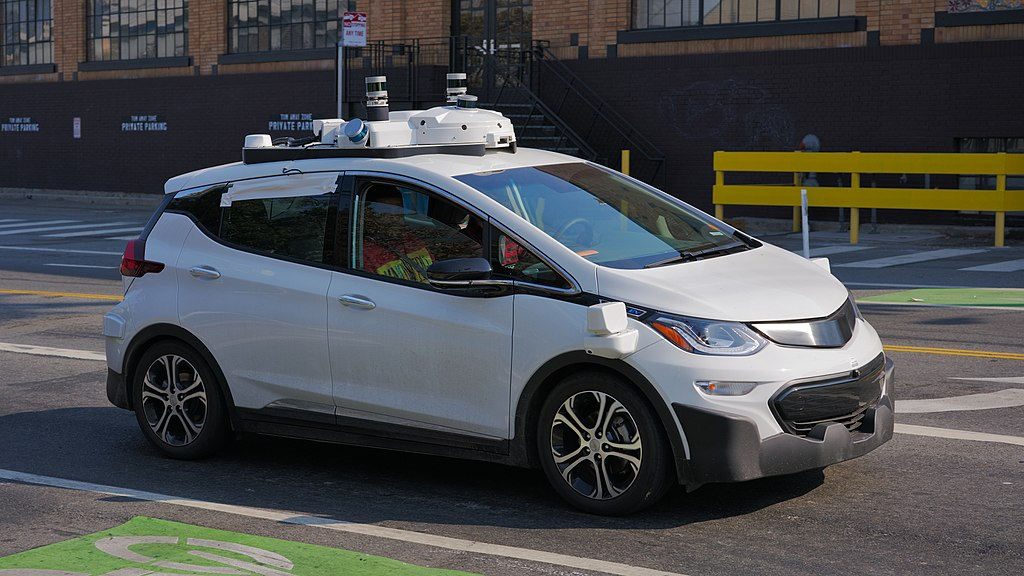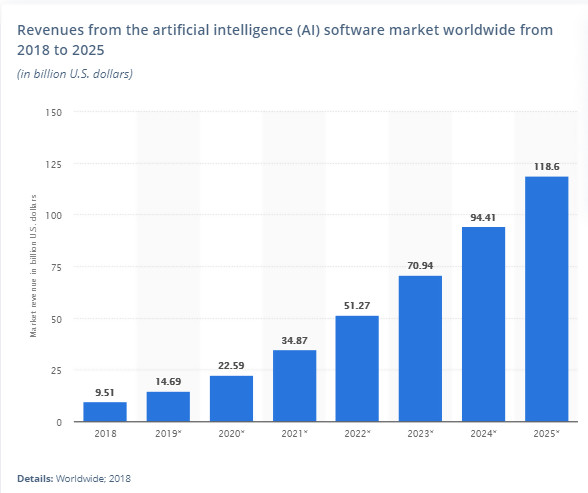Artificial Intelligence (AI) is no longer stuff for the movies but a reality that is unfolding. The technology is slowly permeating human life through driverless cars, the use of algorithms to accomplish tasks, facial recognition and so on. Notably, the presence of AI in emerging technologies is immense. Interestingly, a World Economic Forum analysis concluded that AI “is a key driver of the Fourth Industrial Revolution.”
Driverless cars and robots that stock warehouses are embodiments of what AI can accomplish. According to McKinsey research, close to 70% of companies globally will have adopted AI technology by 2030. The research indicated that many companies would adopt “at least one type of AI technology but that less than half will have fully absorbed the five categories.” Notably, this adoption is already underway, which is driving the expansion of the size of the global AI industry.

The current scenario of the AI industry is positive. Statista data shows that the worldwide AI software market is growing in terms of revenues. In 2018, the market recorded $9.51 billion in AI software revenues. By year-end 2019, Statista estimates that the AI industry will record $14.69 billion in revenues.

What sectors are applying AI the most today?
The McKinsey Global Institute categorizes AI in five broad categories. Notably, the categorization depends on the core applications of the technology. For instance, remote sensing, self-driving cars, face recognition and augmented reality fall under a category of AI called Computer Vision. Other categories include advanced machine learning, robotic process automation, virtual assistants, and natural language.
The application of AI is growing, although at different rates depending on the sector. The self-driving car is the sector that applies AI the most. In particular, this sector applies the computer vision, remote sensing, and face/object recognition segments of AI. The technology helps the self-driving cars to identify and avoid objects when cruising. Notably, Statista estimated that the cumulative revenue between 2016 and 2025 generated from this application of AI to be in the region of $9 billion.

Another sector that is applying AI the most is the digital assistants' sector. Notably, virtual/automated online assistants (also called Chatbots) make up the largest segment of AI-based digital assistants. In 2016, the size of the global chatbot market was just $190.8 million. The market is estimated to grow by 555% to $1.25 billion by 2025.

Some of the major companies involved in the chatbot business include Anboto, Create Virtual, and Nuance Communications among others. Notably, Anboto creates virtual assistant products, intelligent chat solutions, automatic email response solutions, and social media bots.
Which countries are aggressively pursuing AI?
Interestingly, not private companies alone are pursuing AI. Instead, countries like China and the US are aggressively pushing the AI agenda. According to CB Insights, China is the leading country in terms of investing in AI companies. Particularly, CB Insights noted that China intends to spend more than $7 billion on AI by 2030. Notably, the Chinese government is building an AI-focused research park in Beijing worth $2 billion.
The US lacks a clear national policy focused on promoting AI. Nevertheless, the US has managed to stay ahead of countries like the UK and Canada due to research efforts by the private sector, academia, and the military. A study by the Boston Consulting Group noted that China has the highest number of active players in AI (85%) compared to 51% for the US, and 49% for both France and Germany.
Short-term and long-term industry outlook
AI is a great technology that will play a key role in the economic growth of companies in the future. The potential of AI to shape future businesses is underscored by the increased spending on AI solutions by companies. An IDC report showed that by the end of 2019, businesses would spend approximately $37.5 billion on AI systems. Between 2018 and 2023, IDC estimated that the expenditure of AI systems would grow at 28.4% CAGR to reach $97.9 billion.
From the foregoing, companies will maintain a high budget for AI in the short-term but this will increase in the long-term. The reason for the increase in budget allocation is that companies will continue to see the benefits of AI as research and experimentation grows. Statista data backs this claim. In 2018, Statista noted that the revenue from the AI software market was 9.51 billion dollars. This amount will clock $14.69 billion by yearend 2019 and $118.6 billion in six years ahead. In other words, the short-term and long-term outlook of the industry is positive.

